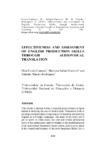Effectiveness and assessment of english production skills through audiovisual translation

Use este enlace para citar
http://hdl.handle.net/2183/35614
Excepto si se señala otra cosa, la licencia del ítem se describe como Atribución-NoComercial 3.0 España
Colecciones
- Investigación (FEDU) [938]
Metadatos
Mostrar el registro completo del ítemTítulo
Effectiveness and assessment of english production skills through audiovisual translationFecha
2022Cita bibliográfica
Couto-Cantero, P., Sabaté-Carrové, M.; Tinedo-Rodríguez, A. (2022). Effectiveness and assessment of English Production Skills though Audiovisual Translation. Current Trends in Translation Teaching and Learning E, 9, 149–182. https://doi.org/10.51287/cttl20225
Resumen
[Abstract] This article is framed within a research project based in Spain aimed at studying the use of Audiovisual Translation tools to develop communicative competences for teaching and learning English as a Foreign Language. The aims of the study are to get to know to what extent the oral and written production skills of the participants improve thanks to the implementation of an Audiovisual translation-based course, and to get to know if the overall performance of the post Integrated Skills Test is better than the pre–Integrated Skills Test after the learning process. It is also aimed to prove the validity of those language assessment tests. A mixed methodology (qualitative and quantitative analysis) was used to obtain information from the participants. Research data was collected from different universities in Spain with an initial sample of 40 applicants, 8 of which finally completed the course. Data analysis shows that oral and written production skills improve thanks to the implementation of six audio description-based lesson plans completed during a pilot course offered during the summer of 2021 to volunteer adult participants with a B2 level in English language. Furthermore, the study illustrates that the results of the final tests are better than the results of the previous ones after the intervention. We discuss the results obtained in this study and conclude that they are harmonious with former studies on the topic as they validate the use of tests to improve the development of communicative skills. Although, there is a very limited number of participants in the sample, we consider this may be used as an example of a trend that will be explored in the future, as this is a pilot study included in a wider research project which is still underway.
Palabras clave
Audiovisual translation
Audio description
Language test
Student evaluation
Second language learning
English foreign language
Integrated skills approach
Audio description
Language test
Student evaluation
Second language learning
English foreign language
Integrated skills approach
Versión del editor
Derechos
Atribución-NoComercial 3.0 España
ISSN
2342-7205






